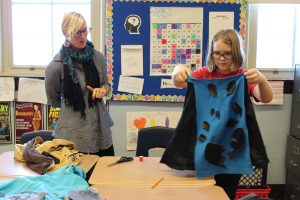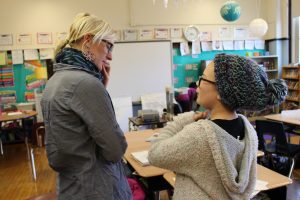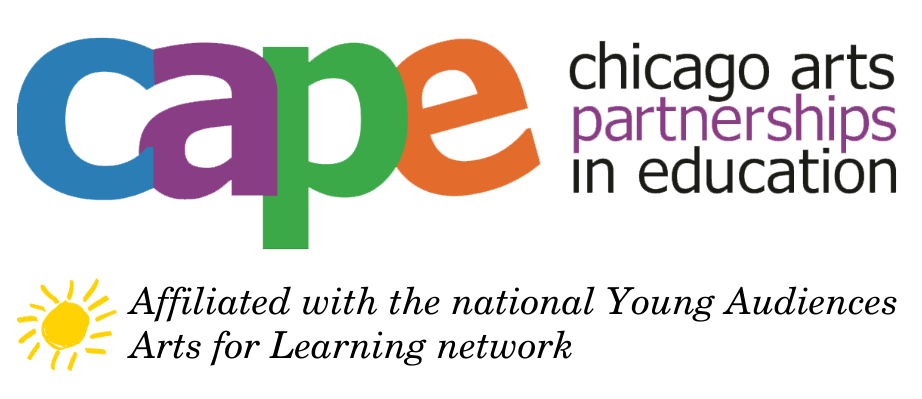CAPE Classrooms: Aloha, Arts! Big Island Visitors Tour CAPE
In April, CAPE hosted two visitors from the Honolulu Museum of Art School in Hawaii: Emma Hussey, an educator, and Justin Davies, Assistant Director of Outreach. In addition to meeting with CAPE Education Director Scott Sikkema, Program Manager Mark Diaz, and Research Program Manager Joseph Spilberg to glean insights into CAPE program and research design, we made sure our big island visitors toured several of our SCALE after-school classrooms to see our work in action at Waters Elementary, Telpochcalli Elementary, and North-Grand High School. After a very busy couple of days, Emma and Justin headed home and later reflected on what they’d seen and learned during their time with us.
Regarding the current and future states of their programs, Emma told us,
“Our current approach to art has been a ‘shotgun’ effect: getting out to as many schools as possible and reaching as many students as possible. This has led to a ‘quantity vs. quality’ approach. We are discovering that this is very hard to keep up with and not as effective as we would like. Going forward we are looking to narrow our approach and be more intentional about the quality of our programs. We want to develop stronger professional development for our teaching artists & classroom teachers to give them support and the tools necessary to deliver quality programs.”

Like the redesigned program Emma describes, CAPE’s priority is on building and maintaining high quality partnerships with our schools, teachers, and teaching artists. Our organization currently supports student programs in 91 schools, which is about 13% of all CPS schools. We’d love to expand our programs to reach every school in the city, but not if that comes at the expense of the intensity of the work. Because every project in every classroom is a multi-year, collaborative effort between a teacher and a teaching artist, rather than a pre-designed, “drop in” curriculum, and because our programs are supported by grants and individual donations rather than school budgets, we only expand our services when we anticipate only being able to support them for multiple years.
Emma also described to us one of the more interesting classroom moments she experienced at our schools:
“Our visit to Waters was very valuable for me. While there, we were able to see a classroom teacher Olga Nunez-Johnson and teaching artist Emmy Bean leading a theater-based class after school. The dynamic between the two teachers was very impressive; it was clear that they are in communication with one another outside of their teaching time to reflect and plan together. Not only was the teaching seamless, but their use of classroom time was very well thought out. This is an example of where I would like to take our teaching artists and classroom teachers. Currently we do not have structures in place that encourage this sort of planning, therefore it isn’t happening, and that is something I would like to change.”
Emma is correct: Before our teacher-teaching artist teams ever step foot inside the classroom together, they go through many hours of professional development and have lots of time to plan one on one and with CAPE staff. This helps to ensure that when the teams do begin their classroom projects, they feel confident about their starting point and supported by each other and our program staff. Co-planning and co-teaching can take some practice, and it’s not always smooth sailing right away. That is why the teams continue to receive professional development and mentorship together throughout the entire school year; obstacles and surprises are common, but with plenty of support and time for brainstorming, troubleshooting, reflection, and planning anew, many unexpected issues become invaluable tools for learning and jumping off points for fresh ideas.

Finally, we asked Emma what she’ll think about most as she and Justin look to the future of their programs at the Honolulu Museum of Art School:
“One of my big takeaways was learning how CAPE’s administrative time is spent in a way that allows the program staff to be constantly reviewing, researching, planning, implementing, and supporting teachers and programs. We are not able to do any of that with our current structure and that is something I would like to change. Also, the way in which CAPE moves forward with an intention to achieve something specific (the inquiry questions in each program, for example) is a very focused approach which helps everyone stay on the same page as the program develops and allows for that inquiry to be answered at the end of the program, so that necessary changes can be made to keep progressing the next year.”
Just as we ask our teachers, teaching artists, and students to inquire, explore, document, collaborate, reflect, and revise, our staff members do the same. We continually examine our work, attempt to answer our own inquiry questions, embrace surprises, and create new questions and goals accordingly. At CAPE, art and research are deeply intertwined and dynamic tools for growth in the office, the classroom, and life.



